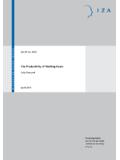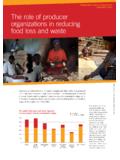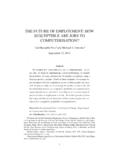Transcription of arXiv:1705.08807v3 [cs.AI] 3 May 2018
1 When Will AI Exceed Human Performance?Evidence from AI ExpertsKatja Grace1,2, John Salvatier2, Allan Dafoe1,3, Baobao Zhang3, and Owain Evans11 Future of Humanity Institute, Oxford University2AI Impacts3 Department of Political Science, Yale UniversityAbstractAdvances in artificial intelligence (AI) will transform modern life by reshaping transportation,health, science, finance, and the military [1, 2, 3]. To adapt public policy, we need to betteranticipate these advances [4, 5]. Here we report the results from a large survey of machinelearning researchers on their beliefs about progress in AI. Researchers predict AI will outper-form humans in many activities in the next ten years, such as translating languages (by 2024),writing high-school essays (by 2026), driving a truck (by 2027), working in retail (by 2031),writing a bestselling book (by 2049), and working as a surgeon (by 2053).
2 Researchers believethere is a 50% chance of AI outperforming humans in all tasks in 45 years and of automatingall human jobs in 120 years, with Asian respondents expecting these dates much sooner thanNorth Americans. These results will inform discussion amongst researchers and policymakersabout anticipating and managing trends in in artificial intelligence (AI) will have massive social consequences. Self-driving tech-nology might replace millions of driving jobs over the coming decade. In addition to possibleunemployment, the transition will bring new challenges, such as rebuilding infrastructure, pro-tecting vehicle cyber-security, and adapting laws and regulations [5]. New challenges, both for AIdevelopers and policy-makers, will also arise from applications in law enforcement, military tech-nology, and marketing [6]. To prepare for these challenges, accurate forecasting of transformativeAI would be sources provide objective evidence about future AI advances: trends in computinghardware [7], task performance [8], and the automation of labor [9].
3 The predictions of AI expertsprovide crucial additional information [10, 11, 12]. We survey a large, representative sample of AIexperts. Our questions cover the timing of AI advances (including both practical applications ofAI and the automation of various human jobs), as well as the social and ethical impacts of MethodOur survey population was all researchers who published at the 2015 NIPS and ICML confer-ences (two of the premier venues for peer-reviewed research in machine learning). A total of 352researchers responded to our survey invitation (21% of the 1634 authors we contacted). Our ques-tions concerned the timing of specific AI capabilities ( folding laundry, language translation),superiority at specific occupations ( truck driver, surgeon), superiority over humans at all tasks,and the social impacts of advanced AI. See Survey Content for Until Machines Outperform HumansAI would have profound social consequences if all tasks were more cost effectively accomplished bymachines.
4 Our survey used the following definition: High-level machine intelligence (HLMI) is achieved when unaided machines can ac-complish every task better and more cheaply than human [ ] 3 May 2018 Each individual respondent estimated the probability of HLMI arriving in future years. Taking themean over each individual, the aggregate forecast gave a 50% chance of HLMI occurring within45 years and a 10% chance of it occurring within 9 years. Figure 1 displays the probabilisticpredictions for a random subset of individuals, as well as the mean predictions. There is largeinter-subject variation: Figure 3 shows that Asian respondents expect HLMI in 30 years, whereasNorth Americans expect it in 74 from 2016 Probability of HLMIA ggregate Forecast (with 95% Confidence Interval)Random Subset of Individual ForecastsLOESSF igure 1: Aggregate subjective probability of high-level machine intelligence arrival byfuture years.
5 Each respondent provided three data points for their forecast and these were fit to theGamma CDF by least squares to produce the grey CDFs. The Aggregate Forecast is the mean distributionover all individual CDFs (also called the mixture distribution). The confidence interval was generatedby bootstrapping (clustering on respondents) and plotting the 95% interval for estimated probabilities ateach year. The LOESS curve is a non-parametric regression on all data most participants were asked about HLMI, a subset were asked a logically similar questionthat emphasized consequences for employment. The question defined full automation of labor as:when all occupations are fully automatable. That is, when for any occupation, machinescould be built to carry out the task better and more cheaply than human for full automation of labor were much later than for HLMI: the mean of the individualbeliefs assigned a 50% probability in 122 years from now and a 10% probability in 20 2: Timeline of Median Estimates (with 50% intervals) for AI Achieving Human Per-formance.
6 Timelines showing 50% probability intervals for achieving selected AI milestones. Specifically,intervals represent the date range from the 25% to 75% probability of the event occurring, calculated fromthe mean of individual CDFs as in Fig. 1. Circles denote the 50%-probability year. Each milestone is forAI to achieve or surpass human expert/professional performance (full descriptions in Table S5). Note thatthese intervals represent the uncertainty of survey respondents, not estimation were also asked when 32 milestones for AI would become feasible. The full de-scriptions of the milestone are in Table S5. Each milestone was considered by a random subset ofrespondents (n 24). Respondents expected (mean probability of 50%) 20 of the 32 AI milestonesto be reached within ten years. Fig. 2 displays timelines for a subset of Explosion, Outcomes, AI SafetyThe prospect of advances in AI raises important questions.
7 Will progress in AI become explosivelyfast once AI research and development itself can be automated? How will high-level machine intel-ligence (HLMI) affect economic growth? What are the chances this will lead to extreme outcomes(either positive or negative)? What should be done to help ensure AI progress is beneficial? Table3S4 displays results for questions we asked on these topics. Here are some key believe the field of machine learning has accelerated in recent asked researchers whether the rate of progress in machine learning was faster in thefirst or second half of their career. Sixty-seven percent (67%) said progress was faster in thesecond half of their career and only 10% said progress was faster in the first half. The mediancareer length among respondents was 6 progress in AI after HLMI is seen as possible but have argued that once HLMI is achieved, AI systems will quickly become vastlysuperior to humans in all tasks [3, 13].
8 This acceleration has been called the intelligenceexplosion. We asked respondents for the probability that AI would perform vastly betterthan humans in all tasks two years after HLMI is achieved. The median probability was10% (interquartile range: 1-25%). We also asked respondents for the probability of explosiveglobal technological improvement two years after HLMI. Here the median probability was20% (interquartile range 5-50%). is seen as likely to have positive outcomes but catastrophic risks were asked whether HLMI would have a positive or negative impacton humanity over the long run. They assigned probabilities to outcomes on a five-pointscale. The median probability was 25% for a good outcome and 20% for an extremelygood outcome. By contrast, the probability was 10% for a bad outcome and 5% for anoutcome described as Extremely Bad ( , human extinction). should prioritize research aimed at minimizing the potential risks of percent of respondents think that research on minimizing the risks of AI shouldbe prioritized by society more than the status quo (with only 12% wishing for less).
9 Asia (n=68)Europe (n=58)North America (n=64)Other Regions (n=21) from 2016 Probability of HLMIU ndergrad Region HLMI CDFsFigure 3: Aggregate Forecast (computed as in Figure 1) for HLMI, grouped by region inwhich respondent was an regions (Middle East, S. America, Africa,Oceania) had much smaller numbers and are grouped as Other Regions. 4 Asians expect HLMI 44 years before North AmericansFigure 3 shows big differences between individual respondents in when they predict HLMI willarrive. Both citation count and seniority were not predictive of HLMI timelines (see Fig. S1 andthe results of a regression in Table S2). However, respondents from different regions had strikingdifferences in HLMI predictions. Fig. 3 shows an aggregate prediction for HLMI of 30 years forAsian respondents and 74 years for North Americans. Fig. S1 displays a similar gap between thetwo countries with the most respondents in the survey: China (median 28 years) and USA (median76 years).
10 Similarly, the aggregate year for a 50% probability for automation of each job we askedabout (including truck driver and surgeon) was predicted to be earlier by Asians than by NorthAmericans (Table S2). Note that we used respondents undergraduate institution as a proxy forcountry of origin and that many Asian respondents now study or work outside our sample representative?One concern with any kind of survey is non-response bias; in particular, researchers with strongviews may be more likely to fill out a survey. We tried to mitigate this effect by making thesurvey short (12 minutes) and confidential, and by not mentioning the survey s content or goalsin our invitation email. Our response rate was 21%. To investigate possible non-response bias,we collected demographic data for both our respondents (n=406) and a random sample (n=399)of NIPS/ICML researchers who did not respond.
![arXiv:0706.3639v1 [cs.AI] 25 Jun 2007](/cache/preview/4/1/3/9/3/1/4/b/thumb-4139314b93ef86b7b4c2d05ebcc88e46.jpg)

![arXiv:1301.3781v3 [cs.CL] 7 Sep 2013](/cache/preview/4/d/5/0/4/3/4/0/thumb-4d504340120163c0bdf3f4678d8d217f.jpg)
![@google.com arXiv:1609.03499v2 [cs.SD] 19 Sep 2016](/cache/preview/c/3/4/9/4/6/9/b/thumb-c349469b499107d21e221f2ac908f8b2.jpg)











